Angono
Angono (pronounced [äŋˈŋo̞no̞] or [äːˈŋo̞no̞]), officially the Municipality of Angono (Tagalog: Bayan ng Angono), is a 1st class municipality in the province of Rizal, Philippines. According to the 2015 census, it has a population of 113,283 people.[4]
Angono | |
|---|---|
| Municipality of Angono | |
Aerial view | |
 Seal | |
Nicknames:
| |
| Motto(s): Angono: An Artist's Paradise, A Tourist's Haven | |
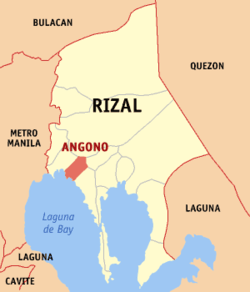 Map of Rizal with Angono highlighted | |
OpenStreetMap 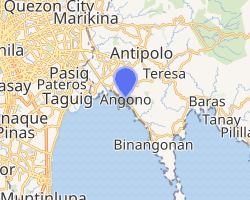
| |
.svg.png) Angono Location within the Philippines | |
| Coordinates: 14°31′24″N 121°09′13″E | |
| Country | |
| Region | Calabarzon (Region IV-A) |
| Province | Rizal |
| District | 1st District |
| Founded | August 19, 1938 [1] |
| Barangays | 10 (see Barangays) |
| Government | |
| • Type | Sangguniang Bayan |
| • Mayor | Jeri Mae E. Calderon |
| • Vice Mayor | Gerardo V. Calderon |
| • Congressman | Michael John R. Duavit |
| • Electorate | 76,349 voters (2019) |
| Area | |
| • Total | 26.22 km2 (10.12 sq mi) |
| Population (2015 census)[4] | |
| • Total | 113,283 |
| • Density | 4,300/km2 (11,000/sq mi) |
| • Households | 24,914 |
| Economy | |
| • Income class | 1st municipal income class |
| • Poverty incidence | 4.31% (2015)[5] |
| • Revenue (₱) | 283,464,815.44 (2016) |
| Time zone | UTC+8 (PST) |
| ZIP code | 1930 |
| PSGC | |
| IDD : area code | +63 (0)2 |
| Climate type | tropical monsoon climate |
| Native languages | Tagalog |
| Patron saint | Saint Clement I |
| Website | www |
Located 30 kilometres (19 mi) east of Manila, and with the continuous expansion of the metropolis, it is now considered part of Metro Manila's conurbation.
It is best known as the "Art Capital of the Philippines", being the hometown of national artist for music Lucio San Pedro and national artist for visual arts Carlos "Botong" Francisco,[6] as well as the site of the Angono Petroglyphs, the oldest known work of art in the Philippines. It is currently campaigning for its inclusion in the UNESCO Creative Cities Network as it is a center for visual arts. It is also campaigning for the inclusion of the Angono Petroglyphs (1 of 5 properties of the Petroglyphs and Petrographs of the Philippines UNESCO tentative site) in the World Heritage List.
First created as a pueblo in 1766, Angono was a barrio of its neighboring town Taytay and Binangonan before it was legally proclaimed an independent municipality in 1938 by then President Manuel L. Quezon.
Etymology
The Name "Angono" was derived from the myth of Panguno which Comes from the word "Ang-uno" which means "The Dwarf"
Barangays
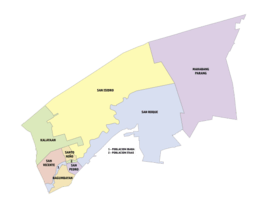
Angono is politically subdivided into 10 barangays: [3]
- Bagumbayan
- Mahabang Parang
- Poblacion Ibaba
- Poblacion Itaas – the least populous barangay with 583 persons
- San Isidro – the most populous barangay with 31,339 persons
- Santo Niño
- San Pedro
- San Roque
- San Vicente
- Kalayaan
Climate
| Climate data for Angono, Rizal | |||||||||||||
|---|---|---|---|---|---|---|---|---|---|---|---|---|---|
| Month | Jan | Feb | Mar | Apr | May | Jun | Jul | Aug | Sep | Oct | Nov | Dec | Year |
| Average high °C (°F) | 29 (84) |
30 (86) |
32 (90) |
34 (93) |
33 (91) |
31 (88) |
30 (86) |
29 (84) |
29 (84) |
30 (86) |
30 (86) |
29 (84) |
31 (87) |
| Average low °C (°F) | 20 (68) |
20 (68) |
21 (70) |
23 (73) |
24 (75) |
25 (77) |
24 (75) |
24 (75) |
24 (75) |
23 (73) |
22 (72) |
21 (70) |
23 (73) |
| Average precipitation mm (inches) | 7 (0.3) |
7 (0.3) |
9 (0.4) |
21 (0.8) |
101 (4.0) |
152 (6.0) |
188 (7.4) |
170 (6.7) |
159 (6.3) |
115 (4.5) |
47 (1.9) |
29 (1.1) |
1,005 (39.7) |
| Average rainy days | 3.3 | 3.5 | 4.8 | 8.1 | 18.9 | 23.5 | 26.4 | 25.5 | 24.5 | 19.6 | 10.4 | 6.4 | 174.9 |
| Source: Meteoblue [7] | |||||||||||||
Demographics
| Year | Pop. | ±% p.a. |
|---|---|---|
| 1903 | 2,231 | — |
| 1939 | 3,896 | +1.56% |
| 1948 | 5,255 | +3.38% |
| 1960 | 7,093 | +2.53% |
| 1970 | 12,127 | +5.50% |
| 1975 | 17,574 | +7.72% |
| 1980 | 26,571 | +8.62% |
| 1990 | 46,014 | +5.65% |
| 1995 | 59,444 | +4.92% |
| 2000 | 74,668 | +5.01% |
| 2007 | 97,209 | +3.71% |
| 2015 | 113,283 | +1.93% |
| Source: Philippine Statistics Authority[4][8][9][10] | ||
In the 2015 census, the population of Angono, Rizal, was 113,283 people,[4] with a density of 4,300 inhabitants per square kilometre or 11,000 inhabitants per square mile.
Local government
- Jo Ann Saguinsin (NPC)
- Sherween Lagaya (NP)
- Patnubay Tiamson (NP)
- Armando Villamayor (NPC)
- Bryan Cruz (NPC)
- Leah Villalon (NPC)
- Roberto Sison, Jr. (NPC)
- Jose Ruben Unidad (NPC)
- ABC President: PB Jonathan Hernandez
- SK Federation President: Bernard Joecel “BJ Tolits” Forbes
Mayors
| Name | Title | Served (From) | Until |
|---|---|---|---|
| Antonio P. Ibañez | Mayor | 1938 | 1940 |
| Domingo S. Villamayor | Mayor | 1940 | 1946 |
| Demetrio Tolentino | Mayor | 1946 | 1947 |
| Antonio P. Ibañez | Mayor | 1947 | 1950 |
| Ponciano A. Rivera | Mayor | 1950 | 1951 |
| Roman S. Reyes | Mayor | 1951 | 1955 |
| Saturnino V. Tiamson | Mayor | 1955 | 1957 |
| Ponciano A. Rivera | Mayor | 1957 | 1972 |
| Saturnino V. Tiamson | Mayor | 1972 | 1986 |
| Nemesio B. Miranda | OIC | 1986 | 1988 |
| Vivencio B. Villamayor | Mayor | 1988 | 1995 |
| Saturnino V. Tiamson | Mayor | 1995 | 1998 |
| Gerardo V. Calderon | Mayor | 1998 | 2007 |
| Aurora A. Villamayor | Mayor | 2007 | 2010 |
| Gerardo V. Calderon | Mayor | 2010 | 2019 |
| Jeri Mae E. Calderon | Mayor | 2019 | present |
Economy
There are several business establishments present in the booming town of Angono. The SM Center Angono is considered as one of the major businesses in town. Trade and commerce are active, such data processing, pawnshops and banks as well. With nearly 100,000 inhabitants in this urbanized town, progress is at its peak. The proposed Angono Fish Port to be constructed at the lakeside shore of Laguna de Bay will soon boost more business opportunities and easier access from the nearby towns situated at the shores of the said lake.
Angono is known as the Arts Capital of the Philippines. With the existence of numerous business establishments and leisure hubs/historical sites, this town is surely a tourist destination.
Culture

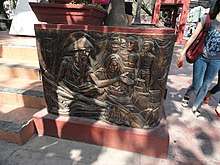
Angono is the hometown of two national artists, Lucio San Pedro for music and Carlos "Botong" Francisco for visual arts.[6] One of the public schools in Barangay Mahabang Parang is named Carlos "Botong" V. Francisco National High School in honor of the said artist. The town also boasts of other artists like Nemi Miranda known as Nemiranda, Perdigon Vocalan, Jose "Pitok" Blanco and the Blanco Family. Around the town are artworks like various sculptures.
Angono also boasts of several actors/actresses Joey Hipolito, Freddie Reynoso, Zoraida Sanchez, Mike Tan, Nikki Gil, and BJ Forbes; news anchor Sandra Aguinaldo and film director Cathy Garcia-Molina.
The artistic town of Angono celebrates the feast of Pope St. Clement I every November 22 to 23 of each year. There are times that this coincides with the feast of Christ the King. The celebration starts with the novena mass on the 14th till 22nd day of November, the devotees in prayer and thanksgiving, dance in the church patio after the novena mass. The dancing was accompanied by the Angono band with the church bell ringing after playing the music.
The town is currently campaigning for its inclusion in the UNESCO Creative Cities Network as it is a center for visual arts. It is also campaigning for the inclusion of the Angono Petroglyphs (1 of 5 properties of the Petroglyphs and Petrographs of the Philippines UNESCO tentative site) in the World Heritage List.
Bisperas Mayores
The Bisperas Mayores or the day before the feast day was celebrated with a parade of the marching bands and drum and lyres sponsored by each barangay of Angono, this was held in the morning and early afternoon. The morning parade usually starts in Rainbow Village and ends at the church patio where the devotees again dances in praise and thanksgiving while the marching bands are playing. The afternoon parade are also joined by the higantes, local government officials and employees, commercial establishments in Angono, schools and other Angono socio and civic groups.
The celebration on the morning of November 23 starts with a concelebrated mass with the Bishop of Antipolo. The procession follows after the mass with the parehadoras, higantes and devotees joining the image of St. Isidore the Laborer, Pope St. Clement I and the Virgin Mary in a procession leading to the banks of Laguna de Bay in Barangay San Vicente for the fluvial procession, fishes like kanduli, tilapia and bangus which are caught by the fishermen devotees during the fluvial procession are displayed near the image of Pope St. Clement I. The images, devotees and member of the band ride the pagoda for the procession in the lake which will end at the other side of the lake in Barangay Poblacion Ibaba. The road procession again will start with merry making of parehadoras, higantes and wet devotees that will end in the church. Filipino artistry is truly alive in every celebration in Angono.
Cristo Rey
The feast of Christ the King which was held on the Sunday before the 1st Sunday of Advent usually coincides with the feast of Pope St. Clement I. The Viva San Clemente! celebration banners usually includes “Mabuhay ang Kristong Hari !” slogans to remind the people that Christ is the Lord and to proclaim Christ as the King of all nations. This is also a reminder that Pope St. Clement I is only a servant of God which somehow does not need adoration of the people because our Lord has already given him the highest honor – a blessing of a Saint – Angono’s patron and inspiration. Viva San Clemente
Pope St. Clement I was the fourth pope of the Catholic Church after Pope St. Peter the prince of the apostles, Pope St. Linus, and Pope St. Anacletus. He faithfully proclaim Christ during his time and till he was martyred by being thrown into the sea with an iron anchor. The people of Angono celebrate Pope St. Clement I's feast day with a fluvial procession in the waters of Laguna de Bay as a reminder and inspiration of his faith in God.
Higantes Festival
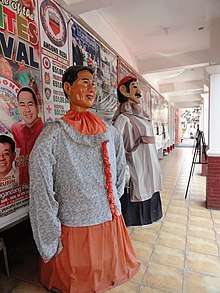
Angono’s joyous fiesta in honor of Pope St. Clement I whose image, resplendent in papal vestments, is held November 22–23, and involves a procession accompanied by parehadoras devotees dressed in colorful local costumes, wooden shoes and carrying boat paddles and higantes, giant paper mache effigies. The street event culminates in fluvial procession at the Laguna de Bay amidst revelry that continues until the image is brought back to its sanctuary.
Higantes Festival is now promoted as tourism-generating event in the country. This attracts numerous tourists from all over the world.
It was said that the higantes started during the Spanish colonial times. When Angono was once a hacienda and ruled by Spanish hacienderos The Guido. The Angono land tillers way of protesting their struggle is by making giant effigy of their landlords whose hands are usually high up on their waist.
The body of the traditional higante are made of bamboo and colorful cloth and its faces of paper mache. The three old higantes of Angono consists of the family of giants – the father, mother and child higante, they traditionally add color and fun during the fiesta celebration. It was in the 80s when then Angono artist Perdigon Vocalan brought the idea of the Higantes Festival by going out of the traditional family of giants and advocating having more higantes in the fiesta by coordinating with the barangays of Angono to come up with Higantes that will represent their barangay. At present, the Higantes of Angono can be seen in fiesta celebrations around the Philippines and in national cultural presentations, the major being the Centennial Parade in the Quirino Grandstand for the Philippine Centennial celebration in 1998.
The higantes are made of paper-mache. Higantes measures four to five feet in diameter and ten to twelve feet in height. Traditionally, it began in the last century when Angono was a Spanish hacienda. This higantes was influenced by the Mexican art form of paper-mache brought by the Spanish priests to the Philippines.
Parehadora
The traditional parehadoras are group of young girls holding paddles and wearing bakya or wooden slippers and dressed in a colorful outfit which joins the procession in the feast day of Pope St. Clement I. They usually march at the beat of the band playing alongside with them. Now with a dying lake, the tradition of the Parehadora is now just a reminder that Angono was once a fishing village and thrives at the harvest of Laguna Lake.
Salubong
Black Saturday is highlighted by 3-hour presentation of “Vigilia na Muling Pagkabuhay” at the patio of the church. On Easter Sunday, a celebration is held of the reunion of the Risen Christ with Virgin Mary is reenacted. It is facilitated by young girl inside an inverted giant paper flower suspended the removal of the mourning veil from Mary’s head by a from bamboo trellis. The petals are mechanically opened by giant toy birds to reveal the girl inside. It is then followed by a religious dancing of young ladies called “Kapitana” and “Tenyenta”, to the tune of “Bati”.
Religion
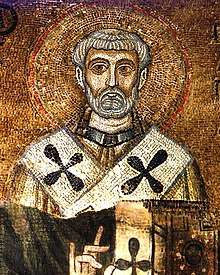
Christianity is the major religion in the town, and the majority of all Christian denomination is Catholicism and a minority of Iglesia ni Cristo, Members Church of God International Born Again, Jehovah's Witnesses and more.
Educational Institutions
Private Schools
- ALC High School
- Angono Christian School
- Angono National High School
- Angono Private High School
- Baby Jesus Chrissamore Learning Center
- Blanco Family Academy
- Charis Praise Christian Academy
- Christ the King College of Angono
- Colegio De San Clemente
- Crossmount School of Arts and Trades
- Eastern Light College
- Faderoga's Learning Center
- Gingergrace Academe
- Holy Deliverance Integrated Christian School
- Hope Academy
- Jason Harvey Academy
- Jonathan T.M. Caballero Academy of Special Needs
- Joyland Playschool Childcare and Learning Center
- Lakeside Hills Learning School
- Little Footprints Playschool and Tutorial Center
- Little Lambs Learning Center
- Maranatha Christian Academy
- Marrieve of Light School
- Mind Slot Integrated School
- New Hope in Faith School
- Praise Christian Academy
- Raises Academy
- Regional Lead School for the Arts in Angono
- Seven Angels College
- Shinil Cristian Academy
- St. Catherine Learning Center
- St. Martin Montessori School
- Santo Entiero Learning Center
Health Institutions
- Angono Medical Hospital
- St. Clement Medical, Inc.
- Rizal Provincial Hospital
Catholic Church
- St. Clement Parish, Barangay Poblacion Ibaba
- St. Joseph the Worker Parish, Barangay Mahabang Parang
References
- https://m.facebook.com/notes/ang-nuno/kasaysayan-ng-angono-rizal-mula-sa-panahon-ng-mga-espanyol-hanggang-sa-panahon-n/134643163253506/
- "Municipality". Quezon City, Philippines: Department of the Interior and Local Government. Retrieved 31 May 2013.
- "Province: Rizal". PSGC Interactive. Quezon City, Philippines: Philippine Statistics Authority. Retrieved 12 November 2016.
- Census of Population (2015). "Region IV-A (Calabarzon)". Total Population by Province, City, Municipality and Barangay. PSA. Retrieved 20 June 2016.
- "PSA releases the 2015 Municipal and City Level Poverty Estimates". Quezon City, Philippines. Retrieved 1 January 2020.
- http://newsinfo.inquirer.net/744307/higantes-art-engraved-in-angono
- "Angono: Average Temperatures and Rainfall". Meteoblue. Retrieved 11 May 2020.
- Census of Population and Housing (2010). "Region IV-A (Calabarzon)". Total Population by Province, City, Municipality and Barangay. NSO. Retrieved 29 June 2016.
- Censuses of Population (1903–2007). "Region IV-A (Calabarzon)". Table 1. Population Enumerated in Various Censuses by Province/Highly Urbanized City: 1903 to 2007. NSO.
- "Province of Rizal". Municipality Population Data. Local Water Utilities Administration Research Division. Retrieved 17 December 2016.
External links
| Wikimedia Commons has media related to Angono, Rizal. |